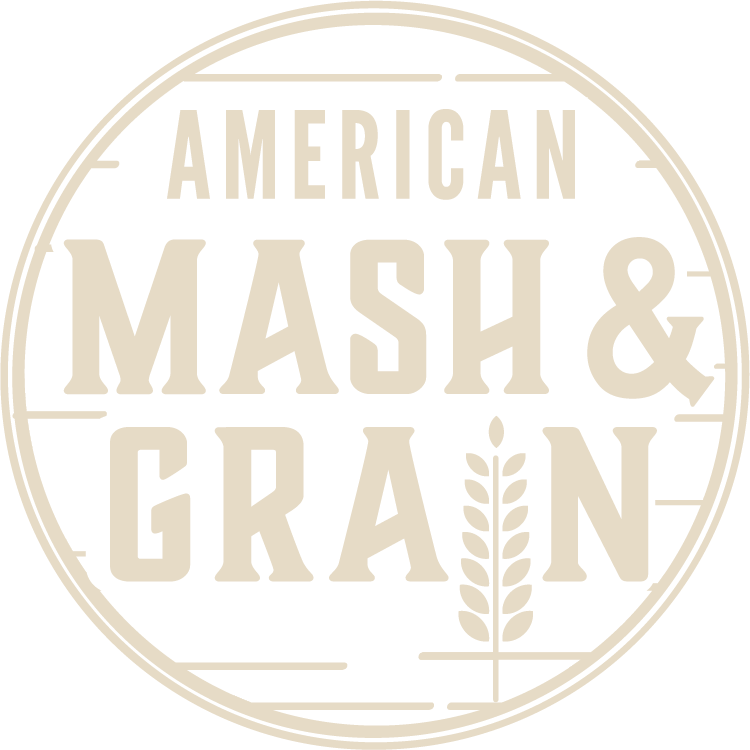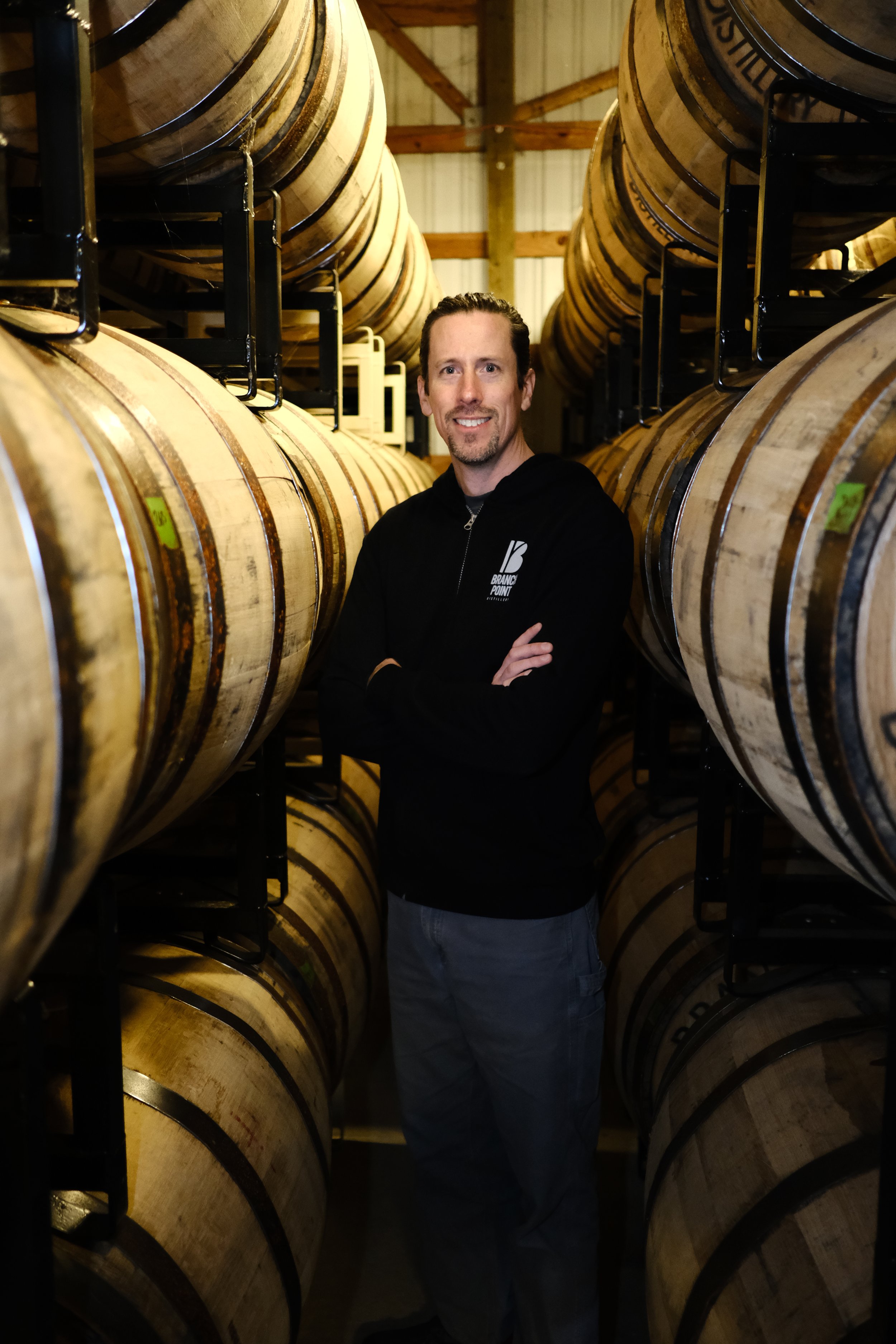Branch Point Distillery
By Meghan Swanson
Portland, Oregon was a different place back in 2007. Back before the Rose Garden became the Moda Center, three years before the show Portlandia proclaimed the ‘Dream of the ‘90s’ still lived there, before Guy Fieri’s convertible had ever pulled up in front of Pok Pok - it was weird, and proudly so, and it was just the kind of place where Steven and Debra Day could ‘escape the Midwest’ (their words, not ours). Steven, a neurologist, and Debra, a CPA by training, were looking for a mid-sized city that had the amenities they were used to but didn’t have the harsh winters they’d endured their whole lives so far. They landed in Portland, the place people joked at the time was ‘where young people go to retire’. Fifteen years later, Steven and Debra are busy as ever - they never retired, and in addition to Steven’s medical career, they have a full-fledged, uniquely Oregonian distillery to show for it.
Steven grew up in Illinois (ironically, in a dry town). He has a mind for science, and took as many advanced biology courses as he could back in high school. “Like most of us in medicine,” he says, he wanted to use his aptitude for the sciences to help people. This drew him into medical school, to Minnesota where he met Debra, and then to St. Louis where he spent his residency. When he and Debra relocated west, they landed smack in the middle of a craft cocktail boom sweeping Portland’s bars and restaurants. Bartenders were doing their historical research and bringing back pre-Prohibition cocktails, sharing nearly-forgotten flavors with modern drinkers. “I got into whiskey through the cocktail door, so to speak.” Steven tells us. “I’m someone who gets deep into things when I’m interested in it.” he says. A full-time practicing physician, he needed a creative outlet outside of his work: whiskey, it seemed, was the answer.
“In twenty years, wouldn’t it be cool to be doing that too?”
One doesn’t become a neurologist without having a certain goal-oriented mindset and willingness to work hard. Steven’s new interest in whiskey glowed in his mind, drawing him into the world of distillation like the warm light of a pub window on a rainy winter night. He started to gather magazines, books–even textbooks–about whiskey. In the early 2010s, Oregon was ahead of many states in adopting early western craft distillers. Steven had the luxury of having multiple craft distilleries in Portland to visit and learn from - something aspiring distillers in other areas of the country could only dream of. Steven is pragmatic; maybe he saw too many people fade out on the path to an M.D., or maybe he just knows better than most that life is short, and he wanted to be sure he didn’t use too much of his on something that he wouldn’t ultimately like. He, as he puts it, ‘got serious’ about his desire to make whiskey, and started doing what any person who’s spent the better part of a decade in school would do - he studied.
It started with a half-day course offered by New Deal Distillery right there in Portland. From there, Steven spent an entire week with Dry Fly Distilling in neighboring Washington state. He went to Chicago for a course with KOVAL Distillery, and then on to the heart of bourbon country to enroll in Moonshine University in Kentucky. “I wanted to get as much information as possible and kind of assimilate it into my own process.” he explains. His classes gave him a look at the day-to-day realities of distilling, and, happily, he wasn’t dissuaded. “It really did seem like fun work.” he says with a rare smile. In 2013, he and Debra would take the plunge, buying the property where Branch Point Distillery would eventually stand.
Why, with the success of craft distilling in Portland and a ready cocktail scene, didn’t they build Branch Point there? As part of his research on entering the world of distilling, Steven had traveled to Scotland to see what their distillery scene was like. He was struck by how the Scottish distilleries were out in the ‘middle of nowhere’, while craft distilleries here in the U.S. tended to be in urban industrial parks. “Rather than starting a distillery in an industrial park, we thought ‘Let’s be out in the country where the grains are grown.” he explains. He and Debra chose a site in Dayton, OR, nestled south of Portland in the fertile Willamette Valley. Some of the best pinot noir wine in the world comes from there; as Steven explains it, the fields that aren’t growing grain are growing grapes. “When we were living in Portland…we would come out to wine country and visit, and you’re only 30 miles from the city, but you feel like you’ve traveled a long distance…it really feels different. I think it makes the experience of being out here feel like you’re in a different place and you can really relax,” Steven tells us. “We wanted that for ourselves, in terms of a place to work, but also for people who are visiting.” he says.
“It met that need for still engaging my brain with the science, but having a fun kind of, creative expression or result different than my day job.”
As Steven immersed himself into whiskey production he noticed echoes of his undergrad biological and organic chemistry courses. “I quickly saw there’s this science underlying whiskey production.” he tells us. One would think this would draw him to a high-tech, cutting-edge path to whiskey production, but he took the opposite approach and chose simple, traditional methods. After all, Steven and Debra had constructed their distillery in a rural location for a reason. “We moved out to be closer to the farmers so we could partner directly with farmers and source grain directly from them.” Steven says. Branch Point would carry on an important Oregonian tradition: that of the craft beverage producer. “The Pacific Northwest has a long history in craft brewing, and wineries pre-dated craft brewing…those industries are well-established here.” Steven explains.
Steven and Debra wanted to keep their product uniquely Oregonian and be truthful about their origins. “I wasn’t trying to pretend I am the fifth-generation—something,” Steven laughs. He’ll tell you he’s not a natural marketer, not an extrovert. “It was such a weird idea, it wasn’t in my plans…I was gonna be a physician and that was gonna be it.” he recalls. It was this unexpected turn of events that made Steven and Debra name the distillery Branch Point. “Most of us have that experience where we look back…and we say, ‘Gosh, if I hadn't have taken that job I wouldn’t have met that person’, or ‘I went on that vacation and wow, it opened my eyes to a world I didn’t know existed.’” he says. “Moving out to the Pacific Northwest…that decision, for us to move out here, was a significant branch point.” he explains. It’s an experience both intensely personal in nature and universal; all of us can think back to a branch point in our own lives.
The process of developing Branch Point’s logo took a meandering path. They went through many iterations of logos trying to evoke a branch point; tree branches, river branches, branching roads. Steven knew he wanted something clean, uncluttered, and symbolic of taking the road less traveled. “You walk in a liquor store, you see the labels…there’s a lot of them that are in a theme–parchment–I would say our brand is definitely not that.” he tells us. They have avoided classic whiskey aesthetics purposefully. As they continued to work through different versions of the logo, Steven found himself paring down each version, getting more and more simple until they reached the bold, simple ‘B’ that adorns their logo today. The design within the capital ‘B’ could be a tree branch, a forking country road, a tributary splitting off into a new river on a map, or even an image of a blood vessel in a human brain–perhaps, like the experience of a branch point in one’s life, it evokes something different for different people.
“I’m the only production guy. I’ve made every drop of whiskey since 2016, I don’t have an assistant.”
“We’re not trying to make a whiskey that’s made elsewhere. A lot of whiskey enthusiasts are explorers, they’re wanting to taste new flavors, see what this other style is,” Steven expands. “Because Oregon is not exceptionally well-known as a whiskey-producing state, it is kind of calling out to people who are explorers in the beverage world.” he finishes. One plan Steven was incubating in his mind was for a local rye whiskey. What he didn’t know was that one of the main grain exports for the Pacific Northwest is soft white winter wheat–a variety fellow Pacific Northwest distillery Bainbridge Organic Distillers also uses–and rye is considered a contaminant if it ends up in a farmer’s wheat shipment. None of the local farms would consider growing rye anywhere near their wheat crops. “My plan for a local rye whiskey had been shot down.” Steven tells us. Luckily, Steven is a creative guy–and he had done his homework. While learning at Dry Fly, he was introduced to a grain called triticale (pronounced trittuh-kaylee).
Triticale, a cross between wheat and rye developed in Europe in the late 19th century, was something one of his farmer’s neighbors was already growing. “It’s a horrible business idea to choose a whiskey made from a grain no one has ever heard of.” Steven jokes. “Fortunately, it [triticale] doesn’t come with the baggage of rye. It processes very much like wheat, you don’t have to worry about that wallpaper paste kind of problem that you do with rye.” Thus, Branch Point’s TRIT Straight Whiskey was born. When asked about the flavor, Steven describes it like this: “...the triticale adds some additional layers of flavor [compared to Branch Point’s Oregon Wheat Whiskey], a little more rye spice, stands up a little better in cocktails. The sweetness is different from a bourbon sweetness. I think of it more as a rich vanilla icing rather than candy corn.” It certainly is gathering interest, having been granted a 90-point rating by Whisky Advocate in its Summer 2022 issue and silver medals in the San Francisco World Spirit Competition, Denver International Spirits Competition, and Sunset Spirit Awards, respectively.
“The one I went into this really wanting to do was the single pot style.” Steven recalls. A fan of Redbreast Irish Whiskey, he understood the way the single pot style would open the door for him to be able to have local grains to make local whiskey from. This is an important concept to Steven, and fuels his commitment to the ‘grain-to-glass’ motto. We asked Steven what that means to Branch Point; like a wise professor, he questioned the question. “It’s interesting that that term [grain-to-glass] even has to be used in whiskey production.” he points out. “If you go into a brewpub in Portland, it would be understood that they made their beer. In the world of distillation, even in craft distillation, that’s not always the case.” he specifies. “Grain comes in and whiskey goes out, is what I would say we mean by ‘grain-to-glass’. It is a distinction from those brands that [sourced] whiskey comes in and goes out in bottles.” he explains. The approach is clearly working for Branch Point; their Single Pot Still Oregon Whiskey also earned itself 90 points in the Summer 2022 issue of Whisky Advocate.
Steven’s hard work is obviously finally paying off - all the time he’s been a full-time distiller, he’s also continued to be a full-time practicing neurologist. We asked him, how do you balance the two? “I don’t know that I would call it balance - it’s a lot of time. It’s…two more-than-full-time jobs, honestly.” he says with a wry smile. “There’s no way around the stresses of running a small business, then you add the unique aspects of running an alcohol-related business, which…brings additional oversight and regulation and different stresses.” he explains. He cites Debra’s CPA training as an invaluable resource for their business, and the fact that they don’t have children as something that grants him additional time to pour into his two jobs. “The barrels are our kids - we’re raising whiskey, not raising kids.” he jokes. In truth, he finds the long hours exhausting and rejuvenating at once. “For me, the distillery is actually a way to help balance. Even though it’s a lot of work, it’s almost therapeutic work.” he tells us.
“It is a theme that runs through the whiskey distilleries of the Northwest…at least a segment of us are really trying to lean into ‘Ok, what makes this area unique? What would make our whiskeys unique?’”
Branch Point’s whiskey is made on stills created by Vendome Copper & Brass Works out of Kentucky. When Steven was getting started, he knew he wanted something simple. “We are a whiskey-exclusive distillery. I don’t need a still that can do everything.” he explains. “I wanted this setup of basically mini Scotch stills, and Vendome was willing to do that.” he says. He uses a double-distillation process, and these days puts everything in 53 gallon barrels (his very first year, he put half in 25 gallon barrels). He uses Seguin Moreau Cooperage out of Napa Valley in California. He once used Kelvin Cooperage out of Kentucky, but during the COVID-19 pandemic, trucking costs soared high enough that it was ‘crazy’ to try to ship them to Oregon. “The wood program itself is another thing that’s important to me. To have the best wood possible, and the extended air-drying is an aspect of that.” he says.
The Willamette Valley enjoys a rare mix of Mediterranean and oceanic climates, giving it an environment that Steven likens to a temperate rainforest. It’s cooler and wetter than a classic Mediterranean climate, making it a habitat where little tree frogs peep and ducks can splash with abandon. Their barrel aging warehouse–“Quite frankly, it’s a barn–call it what it is–with a lot of airflow.” Steven sums it up–gives the whiskey an aging experience more on par with Scotland than with Kentucky or Texas’ hotter climates. Branch Point sees about 4% angel’s share per year. “I think the environment of the barrel maturation has to be a component of the gentle flavor profile of the whiskeys, I think it’s a gentle maturation.” Steven explains. As part of his focus on his wood program, Steven has been experimenting with char levels. He uses a #3 for the TRIT, and an even gentler #2 for the Single Pot. A classic #4 bourbon char would be ‘too much’, in his opinion, overwhelming the flavors he’s working hard to tease out of the Oregon grains. Steven’s opinion on bourbon itself, in fact, is similar. “First off I should say I don’t like bourbon. Secondly, I’ll tell you that I’ll be releasing a bourbon next month [at the time of publication, Branch Point’s Bottled in Bond Straight Bourbon Whiskey is available]…but I will never make bourbon again.” he vows. He alludes to ‘horrible’ production stories. “Let’s just say ‘polenta’. You can take it from there.” he surmises.
“The sensibilities you see in the brand really are a reflection of who we are as people.”
Steven and Debra’s distillery is something unique; started by two midwesterners but embracing the culture of the Pacific Northwest with open arms. A purpose-built distillery being run by someone who still holds–and more importantly, still enjoys–his other, full-time career. A substance renowned for its power to alter the mind being lovingly produced by a physician who dedicates his time to treating diseases of the brain. Highly scientific distillation processes tempered by the soft ripe grains grown by neighbors and the dolorous echoes of tradition ringing all the way across the centuries and over the Atlantic Ocean. Its contradictions and quirks fit right into the ethos of the Pacific Northwest, and its origins in the weird, rainy little city of Portland. It might be a different place these days, but different doesn’t mean bad. It just means a new path has been taken, and you never know what you might find at the end; take a drive south of Stumptown, into the beautiful Willamette Valley, and find out.
Tasting Notes
Trit Straight Whiskey (46% ABV)
Nose: Green Apple Jolly Rancher, Honey, Lemon Peel, Cocktail Cherry, Straw
Palate: The mouthfeel is soft and buttery, with sweet flavors of ripe peaches, vanilla and baking spices up front. Cashew nuttiness appears in the midpalate while remaining sweet with hints of cherry, orange peel and dark chocolate cake with a sugary icing finish.
This is a very sweet and delicious whiskey. The buttery mouthfeel mixed with the sweet flavors make for a very easy drink. Overall it may resemble a wheat whiskey more than a rye whiskey, but is honestly a unique expression of the hybrid varietal that is triticale.
Single Pot Still Oregon Whiskey (46% ABV)
Nose: Ginger, Orange, Vanilla, Blueberry Pie
Palate: The mouthfeel is light with lingering heat. It's sweet and tart up front like an apple with vanilla pie crust. Pepper comes in strong in the midpalate followed by whole grain cereal and smoke leading to a slightly bitter green apple skin flavor on the finish.
This is an interesting whiskey. The grain forward flavors make it distinctive, but it does drink a bit younger and less refined on the palate than the Trit whiskey. This one feels a bit like a work in progress. We're excited to see where it goes.





